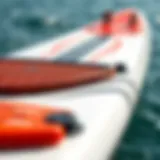The Ultimate Guide to Choosing Kitesurf Gear
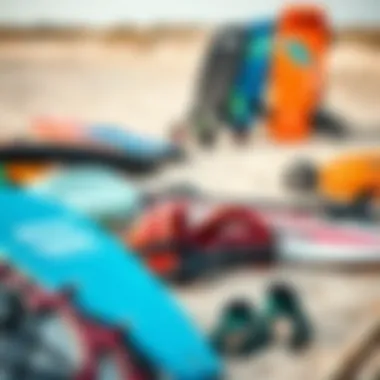
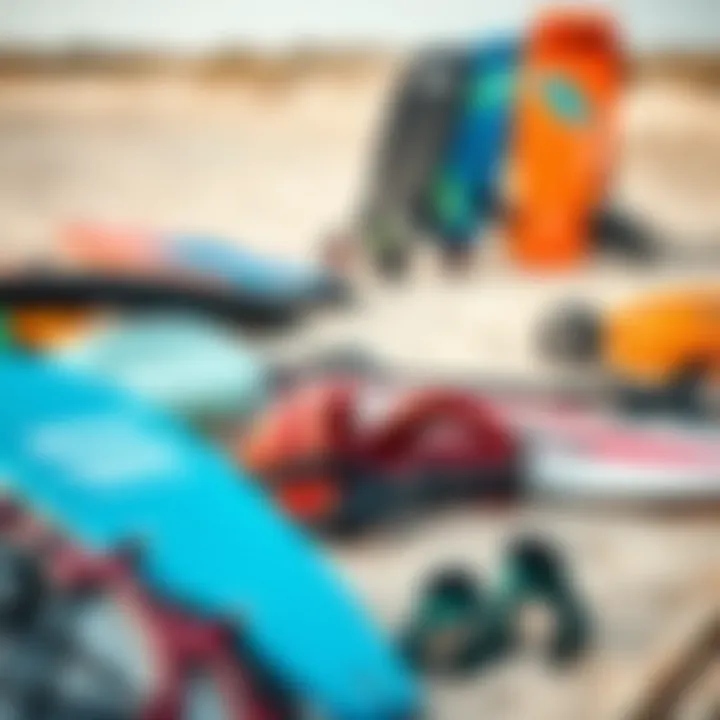
Intro
Kitesurfing is not just a sport; it’s a dance with the wind, waves, and gravity. For those who’ve found their footing on the board and the thrill in the air, understanding equipment is key to enhancing that exhilarating experience. This guide navigates the often-overwhelming world of kitesurf equipment. Whether you’re a rookie eager to dip your toes in the water or a seasoned rider looking to upgrade your gear, knowing what to look for can make the difference between a smooth ride and a rough landing.
In the upcoming sections, we’ll take a closer look at the essential equipment insights and techniques that every kitesurfer should absorb. From the latest gear reviews that spotlight innovations and trends to the crucial aspects of gear maintenance, you’ll find vital information tailored to help you make informed decisions.
"The right gear can save you from a world of hurt while pushing your limits further than you thought possible."
Moreover, we will explore some beginner and advanced techniques that stand to enhance your skill level and overall experience. Stay tuned as we delve into the granular details of this adventure sport, ensuring that whether you're catching air or riding the swell, you’re equipped to enjoy every moment.
Understanding Kitesurfing Equipment
Kitesurfing, a thrilling blend of surfing and flying, relies heavily on the right gear. Understanding kitesurfing equipment is crucial for both novices and seasoned riders alike. When purchasing gear, recognizing the significance of high-quality components can make all the difference in your overall experience, not to mention your safety on the water.
The Importance of Gear Quality
High-quality gear ensures not only the performance of your kite but also your safety. Cheap equipment can lead to issues on the water, potentially risking your well-being. Well-crafted gear can handle varying weather conditions and is more durable, meaning it lasts longer and offers better performance.
- Durability: Stronger materials reduce wear and tear, ultimately providing better value over time.
- Performance: High-quality kites respond efficiently to wind, enabling smoother rides.
- Safety Assurance: Reliable gear is less likely to break down during use, lowering the risk of accidents.
Choosing quality gear is akin to investing in your own well-being and enjoyment.
Key Components of Kitesurf Equipment
In kitesurfing, understanding each component's role and importance is vital. The core elements include kites, boards, harnesses, and control bars, each of which contributes to your overall kitesurfing experience.
Kites
Kites are the heart of kitesurfing equipment. They harness the wind's power, propelling you across the water. An essential consideration is the type of kite you choose—foil or inflatable—with inflatable kites being popular for beginners due to their stability and ease of use. A key characteristic of inflatable kites is their ability to relaunch easily after a crash, making them a favorable option for inexperienced riders. However, they may be less efficient than foil kites in lighter winds. Thus, selecting a kite depends on a rider's environment and preferences.
Boards
The board you ride influences your performance and style on the water. Directional boards are designed for carving and better suited for wave riding. Meanwhile, twintip boards are more versatile, allowing for tricks and riding in either direction. A popular choice among beginners, twintip boards provide stability and are forgiving during learning phases. The unique feature of a twintip board is its symmetrical design, which allows for ease in switching stances, making it a beginner's best friend. Each board type has its own advantages and caters to different riding styles.
Harnesses
Harnesses play a pivotal role in comfort and control. They connect you to the kite and help distribute the load, which can alleviate pressure on your arms. With options like seat harnesses and waist harnesses, the right choice hinges on your riding style and comfort preferences. Seat harnesses offer more support and are favored by beginners, while waist harnesses allow for greater range of motion and are liked by advanced riders. A well-fitting harness can make a world of difference during your session, impacting both performance and comfort.
Control Bars
Control bars serve as the command center for steering and adjusting the kite's angle. Understanding their mechanics is vital for precise control. The bars come in various lengths and setups, and having the right size affects how responsive your kite is to movements. The unique feature here is that many control bars offer adjustable line lengths, which can help accommodate different riding styles or conditions. A well-selected control bar can enhance maneuverability, making your rides more enjoyable.
Understanding kitesurfing equipment, including crucial elements like kites, boards, harnesses, and control bars, directly influences your learning curve and overall experience on the water.
In summary, choosing the right kitesurfing gear involves knowing the ins and outs of each major component. High-quality gear not only ensures a safer experience but enhances your performance, thus allowing you to enjoy the sport to its fullest potential.
Types of Kites
Understanding the various types of kites is crucial for anyone looking to buy kitesurf equipment. Each kite design provides different advantages, which can drastically affect your performance and enjoyment on the water. Knowing the distinctions not only allows you to select the right kite for your ability and preference but also helps you maximize the fun factor while reducing the risks associated with kitesurfing. Whether you are a beginner who is just getting your feet wet or an experienced rider looking for an upgrade, identifying the type that resonates with your style is paramount.
Foil Kites vs. Inflatable Kites
Foil kites are unlike their inflatable counterparts. Made entirely of fabric, foil kites rely on air flow to maintain their shape. They are known for their light weight and can be packed down nice and small, making them a suitable choice for travel. On the flip side, inflatable kites, as the name suggests, utilize air-filled bladders to form their structure. This creates a sturdy frame that can withstand almost any gusty condition, giving them an edge in reliability.
When it comes to performance, foil kites tend to be more efficient in light wind conditions, allowing sailors to catch more air time with less wind. Conversely, inflatable kites shine when it comes to stability and ease of use, especially for those who are new to the sport.
Choosing the Right Kite Size
Picking the right size of the kite is complex and should factor in several aspects that go beyond mere aesthetics. It’s not just about looking cool on the beach, but rather about optimizing your ride.
Weight Considerations
Your body weight is one key aspect when selecting a kite size. Heavier riders generally require larger kites to get the same lift as lighter ones. A kite that is too small for your weight can lead to underwhelming performance, leaving you feeling frustrated.
- Key Characteristic: Larger kites generate more power in lighter wind, making them a popular choice for those who weigh more.
- Unique Features: A larger kite offers a wide wind range, giving you versatility in various conditions. However, it may become unwieldy in strong winds, leading to increased risks if you're not an adept rider.
Wind Conditions
Wind conditions play a pivotal role in your decision-making process for kite size. Winds can vary from gentle breezes on a casual day at the beach to high gusts that require careful navigation.
- Key Characteristic: Understanding the local wind patterns is crucial. A kite size that might work wonderfully in one environment could easily become a liability in another.
- Unique Features: Larger kites perform well in lighter winds, but overestimating their viability in high winds can lead to dangerous situations.
Riding Style
Personal riding style is yet another factor influencing kite choice. Whether you are into speed or freestyle tricks can dictate the dimensions ideal for you.

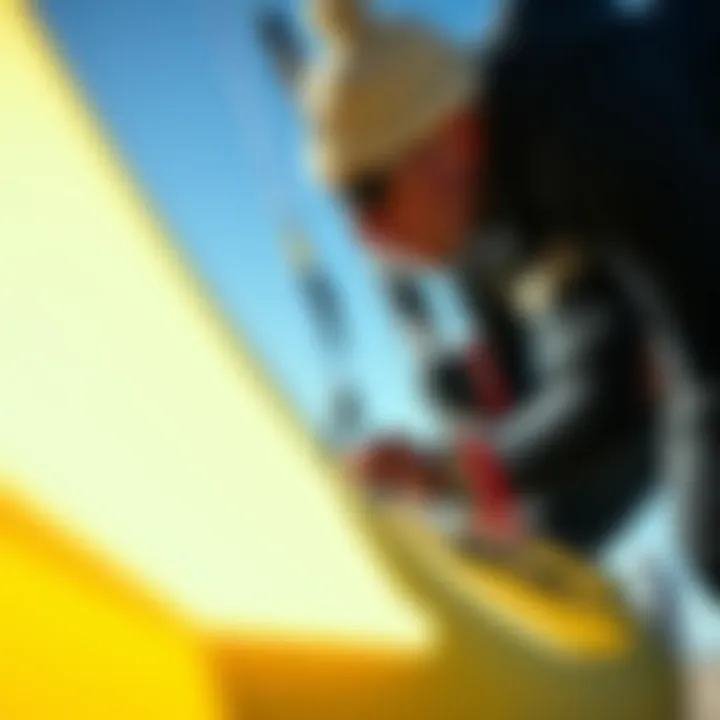
- Key Characteristic: Riders who prefer to jump or do tricks may lean towards smaller kites for snappier response times while those who enjoy cruising might find larger kites more appealing.
- Unique Features: The balance between size and style can significantly impact your overall ride. Riders who opt for the wrong size for their style could find themselves hampered in their performance, leading to serious disappointment.
Choosing the right kite is a blend of many factors, and an informed decision can make the difference between an exhilarating day on the water or a struggle against the elements.
Selecting the Perfect Board
Choosing the right kitesurf board is pivotal in shaping your kiteboarding experience. The board defines how you interact with the water and controls how efficiently you can ride the waves, boost jumps, or glide smoothly. Since kitesurfing involves a variety of styles and conditions, selecting a board that complements your skills and preferences becomes essential. You’re not just picking a piece of equipment; you are choosing a partner for adventure that can make or break your day on the water.
Types of Boards Explained
When it comes to kitesurf boards, the landscape is diverse, much like the ocean itself. Each type suits different riding styles and conditions. Here’s a breakdown of the main types of boards you might consider:
Directionals
Directionals are like the surfboards of kitesurfing. They are designed to be ridden in one direction, hence the name. The distinctive feature of directionals is their pointed nose and often a tail that varies in shape according to the design. These boards excel in wave riding, providing a fluid experience as they handle swells and chop with ease.
The main appeal of directionals lies in their stability and responsiveness in surf conditions. They're favored by kite surfers looking for that pure, surf-like feel on the water. However, they come with a trade-off. They can be less versatile than twin-tips, especially for tricks and jumps. In essence, they demand a slightly more refined technique in handling, making them a great choice for more experienced riders.
Twintips
Twintips are perhaps the most common choice among kiteboarders, and for good reason. Designed with a symmetrical shape, they can be ridden in both directions, allowing for quick switch-ups in riding style. This versatility is a robust point in their favor, particularly for beginners and intermediate riders who are still honing their skills.
An outstanding feature of twintips is their stability and ease of maneuver, which enhances the learning curve for newcomers. You can easily jump and perform tricks without worrying about the direction you’re facing. However, they might not deliver the same level of speed in choppy waters as directionals and can be more affected by the wind on flat water.
Foils
Foil boards introduce a completely different dynamic to kitesurfing. They utilize a hydrofoil which lifts the board above the water once you gain sufficient speed. The unique characteristic of foils is their ability to glide smoothly with minimal drag, even in lighter winds. This feature allows for extended rides when conditions aren't ideal.
Foils can be a game-changer for riders chasing flat water and speed. They provide an exhilarating experience that feels almost like flying, drastically changing how waves and wind are experienced. However, foiling requires a certain skill level to master. The initial learning curve can be steep, but once conquered, it opens a new realm of possibilities for kitesurfing enthusiasts.
Board Size and Shape Considerations
Selecting the correct board size and shape is integral to optimizing your riding experience. Characteristics such as your weight, skill level, and preferred riding style play significant roles in these choices.
Rider Skill Level
Your skill level should guide your board size choice. Beginners often benefit from a larger board that offers stability and ease due to its volume. A bigger size might help in easier planing and handling chop. As you progress, you'll find that choosing a smaller board allows for more agility and performance.
A crucial takeaway is that a board reflects who you are on the water. Stick with larger boards while you're learning the ropes, but don't hesitate to downsize as your confidence grows.
Board Volume
The volume of the board is another critical factor to consider. Volume affects buoyancy and, therefore, how easily the board floats and planes. Higher volume boards are more forgiving in the water, while lower volume options tend to provide better performance for advanced tricks and agility.
Maintaining a balance between volume and your body weight is essential. The right volume helps ensure you won’t sink too much when paddling out, while also allowing for control when you start jumping or doing tricks.
Construction Materials
The materials used in board construction can greatly influence performance. Common materials include wood, fiberglass, and various forms of foam, each offering different levels of durability and weight.
Wooden boards, for instance, can be quite sturdy but heavier, while advanced fiberglass options can offer lightness and responsiveness. Also, the overall design and layering play a crucial role in determining how the board interacts with water.
Understanding these material characteristics arms you with the knowledge to select a board that not only suits your style but also adapts to various conditions.
As you dive deeper into kitesurfing, you'll find that selecting the perfect board isn’t merely about preference; it's about finding that sweet spot between performance, comfort, and adaptability to elevate your ride.
Harness Options
When embarking on your kitesurfing journey, harness options are a crucial factor that can greatly influence your overall experience. The right harness provides not only comfort but also enhanced control during your rides. As you glide over the waves, the harness acts as a bridge between yourself and the kite, allowing for efficient load transfer and maneuverability. Thus, selecting an appropriate harness might be just as critical as picking the perfect kite or board.
Comparing Seat and Waist Harnesses
A common dilemma faced by many kiteboarders, from novices to seasoned riders, is the decision between seat harnesses and waist harnesses. Both have their pros and cons, and the right choice often hinges on personal preference, riding style, and overall comfort.
- Seat Harness: This type wraps around your hips and comes down over your thighs. It's typically favored by beginners for a couple of reasons:
- Provides extra support and stability, reducing the pull on your back.
- Better suited for larger winds as it can help distribute the load more evenly.
However, they can feel restrictive, and some may find them cumbersome if they plan to perform tricks or maneuvers.
- Waist Harness: These sit higher up on the torso and are favored by more experienced riders.
- Allow for a greater range of motion, which is essential for executing jumps and tricks.
- Tend to be lighter and more streamlined, providing a sleeker profile during rides.
On the flip side, they can strain the lower back if not adjusted properly.
Ultimately, comparing these two options should be done with the practical aspects of your kitesurfing lifestyle in mind.
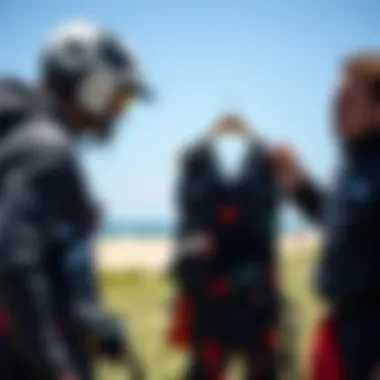
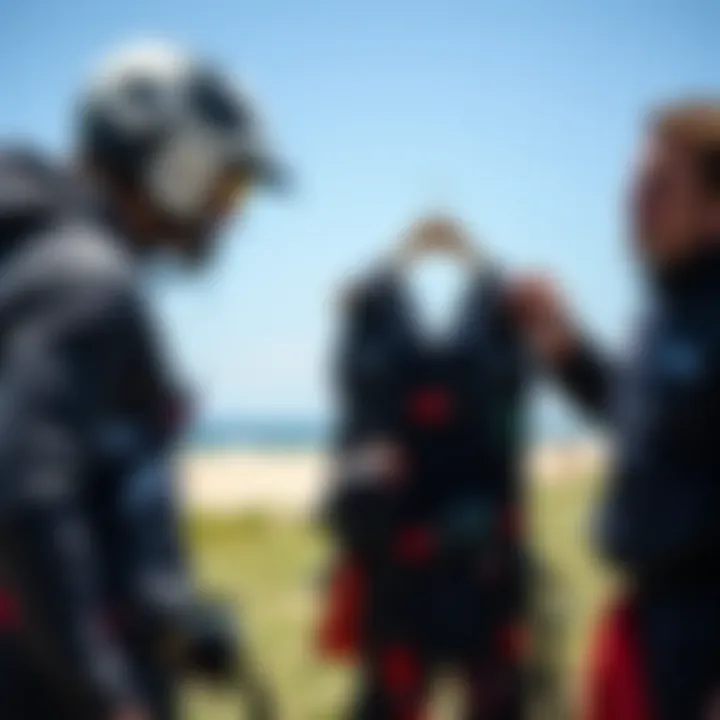
Selecting a Harness Based on Comfort and Fit
Comfort and fit cannot be stressed enough when choosing a harness. A harness that doesn't fit properly can lead to frustrating rides and even long-term discomfort. Here are a few factors to consider:
- Sizing: Make sure to check the sizing charts provided by manufacturers. Each brand may vary slightly, so do not assume you're always a medium.
- Try Before You Buy: If possible, try on the harness. Move around in it; bend, twist, and simulate your riding position. A good fit should feel secure without pinching or creating discomfort.
- Adjustability: Look for harnesses with multiple points of adjustment. Some models feature easy-to-adjust straps that allow you to customize the fit as per your liking.
- Padding and Material: Different materials offer various levels of comfort and support. Be aware of the padding in the back and sides; some may have extra cushioning to enhance comfort during those long sessions on the water.
Control Bars and Lines
When it comes to kitesurfing, control bars and lines might not get the spotlight they deserve compared to kites or boards, but their role is fundamental. This equipment acts as the vital link between the rider and the kite, giving you the authority to steer your rides and maneuver through various conditions. Understanding these components can make or break your experience on the water, so let’s break it down.
Understanding Bar Mechanics
Control bars are equipped with several features that directly affect how you interact with your kitesurf gear. Typically, the bar itself is constructed from sturdy materials like aluminum or composite that can withstand the stress of high wind and water. The grip should feel comfortable in your hands, offering enough friction to prevent slipping without causing fatigue during extended sessions.
One crucial aspect of the bar is its width. A wider bar gives a broader range of motion, which is beneficial in more intense conditions, while a narrower bar might be easier to handle for beginners. Look out for features like the safety release systems, which are designed to help you detach from the kite in emergencies. Having a reliable safety system can certainly save you from difficult situations on the water.
The lines connected to the bars are not just simple chords; they are engineered for different strengths and purposes. Generally, these lines can vary in length, material, and thickness. A thicker rope will handle wear and tear better than a thinner one but could add weight to your setup. Being aware of how each component interacts will ultimately grant you better control and responsiveness, allowing for a more pleasurable kiteboarding experience.
Adjusting Line Length and Material
Line length and material play a critical role in how responsive your kite feels. Most kitesurfers opt for a standard length of roughly 20 to 24 meters, but this can be adjusted depending on your personal preference and the conditions. Longer lines can allow for more lift and speed, but they may also reduce control, especially in gusty winds.
Material-wise, lines made from low-stretch materials help improve responsiveness. Spectra or Dyneema are common choices because they are robust yet lightweight, which reduces drag as climbers go through the motions.
If you decide to adjust line length, ensure that the remaining setup—namely the kite—can still perform well with the new dimensions. A complicated rigging can lead to unexpected issues that might ruin your day at the beach.
"Getting the right setup for your control bars and lines can truly redefine your kitesurfing experience. A well-tuned kite equates to better performance and safety."
Understanding these subtleties about control bars and lines not only enhances your riding but allows you to tailor your setup to suit your personal style. As tempting as it may be to rush through selecting these components, taking your time to thoroughly assess your options pays off in the long run.
Safety Gear Considerations
When it comes to kitesurfing, one cannot stress enough the significance of safety gear. Kiteboarding is an exhilarating sport, but it comes with its share of risks. Proper safety gear not only serves as a safeguard against potential injuries but also enhances the overall kitesurfing experience. Whether you are just starting out or have been riding the waves for years, having the right gear can make all the difference.
Essential Safety Equipment
Helmets
Helmets for kitesurfing have become increasingly essential over the years. These are not just any old helmets; they are designed to absorb impacts from falls and potential collisions. A good helmet will often include customizable padding, which ensures a snug fit, keeping your head safe in turbulent situations.
Helmets made specifically for kitesurfing often come with additional features like a visor to protect your eyes from the sun and wind. They are generally light yet highly durable, ensuring comfort without sacrificing protection. Some kiteboarders consider helmets optional, but if you're serious about safety, investing in a good quality helmet is wise.
"Safety comes first, especially in high-speed sports such as kitesurfing."
Impact Vests
Impact vests are another crucial piece of safety equipment that many kitesurfers use. These vests are designed to cushion your body against the force of the water during falls, providing buoyancy as well. A well-fitted impact vest can reduce injuries dramatically while giving you peace of mind.
The buoyancy aspect adds an extra layer of security, especially for beginners. On the flip side, it can sometimes feel restrictive. However, the benefits far outweigh the disadvantages, especially when high-speed tricks are considered. A good impact vest can be your best friend in avoiding bruises and more serious injuries.
Leashes
Leashes are perhaps one of the most underrated safety tools in kitesurfing. They ensure that your board stays within reach during falls. This minimizes the risk of losing your board and also helps to avoid potential injuries to yourself and others around you.
Most leashes are made from flexible materials that won’t snag easily but still offer enough strength to hold when you crash into the water. One drawback is that a leash can sometimes become tangled, posing a risk itself. Hence, it’s crucial to regularly check your leash for wear and tear to keep it in optimal condition.
Importance of Personal Flotation Devices
Personal Flotation Devices (PFDs) are critical in any watersport, especially kitesurfing. PFDs help keep you afloat should you find yourself in trouble, providing confidence while you're out in the water. That added peace of mind encourages many kiteboarders to push their boundaries, knowing they have an extra layer of safety.
Moreover, many modern PFDs are designed with mobility in mind. Unlike bulkier life jackets, these devices allow for the freedom of movement necessary for tricks and maneuvers. PFDs can sometimes be cumbersome, making it essential to find one that fits comfortably without restricting your movement.
Where to Buy Kitesurf Equipment
When it comes to kitesurfing, knowing where to purchase your gear can be just as important as understanding the equipment itself. The right vendor can substantially influence your kitesurfing experience, from the quality of the products to the support provided. With the increasing options available, both online and offline, it's essential to understand these buying avenues to make a well-informed decision.
Online Retailers vs. Physical Stores
In today's digital age, online shopping has become a convenience many of us can't live without. However, deciding between online retailers and brick-and-mortar stores is crucial for kitesurf equipment.
Benefits of Online Retailers:
- Wider Selection: Online shops often provide a broader range of products than local stores. You might find everything from the latest foil kites to specialized harnesses all in one place.
- Price Comparisons: It's easier to compare prices across several retailers online, helping you catch a good deal. Plus, you can often find exclusive online discounts.
- Product Reviews: Reading reviews from other users on platforms like Reddit can help you gauge the quality and performance of items before buying.
Considerations for Physical Stores:
- Hands-On Experience: Visiting a store allows you to see, feel, and even try the equipment before making a final decision. This can be particularly beneficial when choosing a harness or board.
- Expert Advice: Local shops often have knowledgeable staff who can offer personalized guidance. Their first-hand experience with the equipment can be invaluable, especially for those new to the sport.
- Support Community: Shopping locally helps foster a kitesurfing community, opening doors to local events, lessons, and gatherings, which enhance your involvement in the sport.

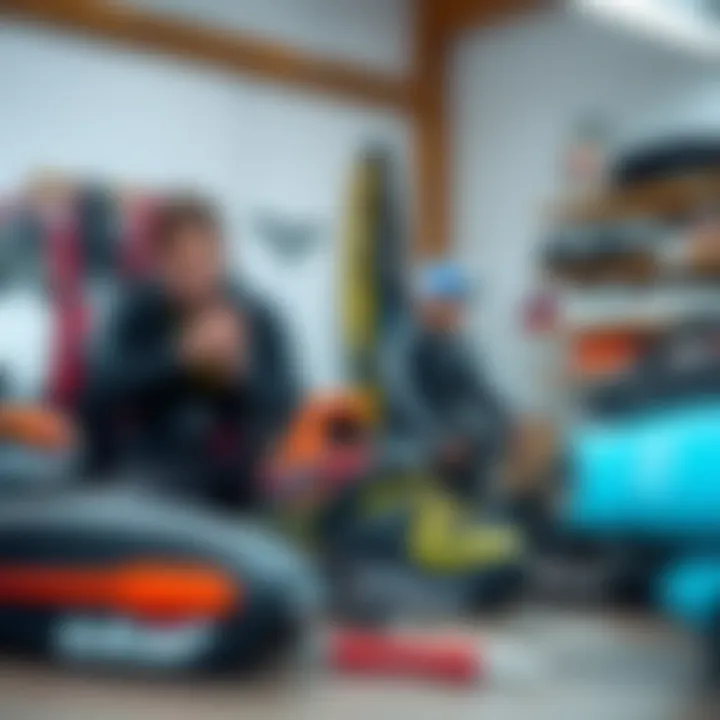
Both options have their pros and cons. If you prefer the instant gratification of trying gear in person, a physical shop might be the route for you. On the other hand, if you've done your research and feel comfortable shopping online, you might score some bargains.
Assessing Trustworthiness of Vendors
Not all vendors are created equal. When it comes to making a purchase, it’s vital to assess the reliability of the shop, whether online or offline. Some indicators of trustworthy vendors include:
- Reputation: Look for reviews or ratings on sites such as Google or Trustpilot. Community feedback can give insight into the experiences of previous customers.
- Return Policy: A solid return policy indicates that the vendor stands behind their products. If they allow returns or exchanges, it shows confidence in the gear they’re selling.
- Certifications: Check for any affiliations with reputable kitesurfing organizations or endorsements from well-known brands in the industry; this can reflect a vendor's commitment to quality.
- Engagement: Engaging with customers through platforms like Facebook or Instagram can help gauge how responsive they are to inquiries and issues. A vendor that is active on social media often demonstrates dedication to customer service.
Finding a reputable vendor goes hand in hand with ensuring you make a sound investment in your gear. When in doubt, a little research can go a long way.
"The best deals are usually hidden behind the dust of online browsing and the smell of a good shop's coffee. Take the time to explore and seek the right fit for your kitesurfing adventures.
Budgeting and Pricing Insights
When it comes to kitesurfing, understanding how to budget and decipher pricing can make or break your experience on the water. Kitesurf equipment isn't cheap; therefore, mapping out your financial approach is essential. This section discusses how to navigate the often murky waters of pricing and to make informed decisions without paddling upstream.
Understanding Price Ranges
Kitesurf equipment prices can vary widely based on several factors, including brand reputation, materials, and technology. Here’s a closer look at what to expect:
- Entry-Level Gear: Generally, a beginner kite setup will cost anywhere from $800 to $1,500. Entry-level gear tends to be simpler and more forgiving, making it perfect for novice riders who may not be ready to invest heavily yet.
- Mid-Range Equipment: For those with some experience under their belts, mid-range gear offers a nice balance of performance and cost—typically from $1,500 to $2,500. Think of it as the sweet spot where quality meets affordability.
- High-End Gear: Advanced riders looking for top-notch performance should be prepared to spend $2,500 and above. This equipment often incorporates the latest technology and materials, allowing for enhanced maneuverability and control.
Taking time to browse and compare prices can lead to unearthing some hidden gems. Beware of comparing apples to oranges; not all brands weave the same quality into their products.
Identifying Value vs. Cost
When making a purchase, acknowledging the difference between value and cost is vital. Cost refers to the price tag displayed on the equipment, while value speaks to what you gain in return—higher performance, durability, and the satisfaction of a product that meets your needs effectively. Here are some tips to navigate this aspect:
- Evaluate Quality: Just because gear comes with a hefty price doesn’t always mean it’s the best choice for you. Check reviews from fellow kiteboarders and experts, and consider gear that has proven itself in various conditions.
- Consider Longevity: A higher upfront cost may mean that the equipment lasts longer, thus providing better value in the long run. Like the old saying goes, "Buy cheap, buy twice."
- Test Before You Buy: If possible, test out equipment before shelling out the dough. Whether at a shop or a community event, hands-on experience can clarify what truly suits your style.
Remember, the aims is to find gear that offers the right balance between what you’re willing to spend and the performance you need.
In the grand scheme, budgeting isn't just about penny-pinching; it's about planning your investment wisely. Each kitesurfing session is an opportunity to connect with nature and enjoy the wind. The goal is to find equipment that helps you do just that without constantly stressing over your wallet.
Product Reviews and Recommendations
In the world of kitesurfing, having the right gear can make or break your experience on the water. Product reviews and recommendations stand out as pivotal resources for anyone looking to invest their hard-earned cash into kitesurf equipment. Reviews provide insight beyond the flashy marketing or glossy brochures. They give potential buyers a peek into the performance, durability, and real-world usability of products through the eyes of fellow riders, fostering a knowledgeable community around the sport.
When exploring kitesurfing equipment, there are several significant elements one should consider from reviews:
- User Feedback: The perspectives of other kitesurfers can highlight both the strengths and weaknesses of a product. A kite that might sound great in theory could fall short in practice, particularly under certain wind conditions or riding styles.
- Long-term Performance: Many reviews touch not just on initial impressions but also on how gear holds up over time. Equipment that excels in durability is crucial for safety and cost-effectiveness, as frequent replacements can quickly add up.
- Comparison Between Products: Reviews often compare multiple items, allowing riders to weigh different options against each other. Having the pros and cons laid out can ease the decision-making process.
Furthermore, engaging with product reviews helps build a sense of trust. When buyers see consistent feedback about a particular kite or harness across various platforms, it fosters confidence that they're making an informed choice.
"The best gear is often what nobody is talking about – the underdogs outperforming the big names. Taste matters, but so does being smart about choices."
Engaging with Kiteboarding Communities
One of the true gems of being a kitesurfer lies in the community that surrounds the sport. Just like any niche activity, the collective wisdom found within kiteboarding communities—whether online or in person—can offer priceless insights that conventional reviews may miss. Websites like Reddit and dedicated Facebook groups are teeming with an array of enthusiasts ready to share their experiences.
Participating in forums or local clubs can provide a hands-on perspective of equipment before purchase. Riders discuss everything from their first impressions to long-term usage, highlighting how gear behaves in varying conditions. Here, newcomers can interact with seasoned veterans who can point out hidden features and drawbacks; you might learn, for instance, that a specific board is excellent in choppy waters but not so great for flat conditions.
Additionally, engaging with the community opens doors for real-time feedback about local shops or online retailers. A seasoned kiteboarder may share horror stories about poor customer service and recommend stores where they had positive experiences, guiding you away from potential pitfalls.
Analyzing Expert Reviews
While user feedback is essential, expert reviews can serve as a solid foundation for understanding the intricacies of kitesurf equipment. Experts often test gear under consistent conditions and through a rigorous set of criteria—making their evaluations quite detailed.
Key factors analyzed in expert reviews usually include:
- Innovative Features: Professionals often discuss the technology integrated into various kites or boards. Understanding these innovations can be key to distinguishing between similar-looking products.
- Performance Under Pressure: Experts simulate real-world scenarios, assessing how different gear performs in diverse wind speeds and water conditions, illustrating how an item stands the test of time.
- Safety Aspects: Top reviewers don’t just care about performance; they also evaluate safety features that affect their overall ratings. Considering this could guide you to equipment that prioritizes your well-being while you focus on enjoying the sport.
In summary, relying on both community-engaged experiences and expert evaluations creates a well-rounded understanding of the kitesurf equipment available today. By gathering knowledge from various sources, one walks into a kite shop or navigates an online retail site equipped to make a smarter choice.
Caring for Your Equipment
Kitesurfing is not just a thrilling sport; it also requires a significant investment in quality gear. After pouring out your hard-earned cash on kites, boards, and harnesses, you'd want to ensure they last. That's where caring for your equipment comes into play. Proper maintenance not only extends the lifespan of your kitesurf gear but also ensures you have a safer and more enjoyable experience when you're riding the waves. Whether you're a weekend warrior or a seasoned pro, neglecting your gear can lead to costly replacements or, worse, accidents.
Maintenance Tips for Longevity
Taking care of kitesurf equipment is essential for keeping everything in tip-top shape for the long run. Here are some top maintenance tips:
- Rinse with Fresh Water: After each use, especially in saltwater, give your gear a good rinse. Salt can corrode equipment, plus it can mess up the materials over time.
- Inspect Regularly: Take a good look at your kites, lines, and boards. Look out for wear and tears, especially in areas that bear stress. If something looks off, it probably is.
- Dry Thoroughly: Always allow your gear to dry completely before storing it. This is crucial because moisture can lead to mold or degradation of materials.
- Store Properly: Avoid leaving your equipment in direct sunlight for days on end. Store it in a cool, dry place. Using a protective bag can also help.
- Check your Lines: Lines take a beating and need to be replaced periodically. Inspect for any fraying or damage that could lead to failure while kitesurfing.
“A stitch in time saves nine”—fixing small issues prevents bigger ones.
Storage Solutions for Kitesurf Gear
Storing your kitesurf equipment may not sound glamorous, but it's vital for ensuring it doesn’t get damaged when not in use. Here’s how to tackle storage:
- Use a Gear Bag: Invest in a good kitesurf bag that can accommodate your kite, board, and harness. Check that it has ample padding. If your bag can double as a backpack, even better for carrying everything out to the beach.
- Avoid Attachments in Storage: Remove any straps or accessories before storing. This helps in reducing unnecessary pressure on materials and avoids bending or crumpling.
- Temperature Control: Try to keep your gear in places where temperatures don’t fluctuate too much. Gear left in hot places can degrade much faster than expected.
- Store Boards Vertically: If you have the space, storing boards vertically can minimize stress on the board's structure. It prevents warping and allows airflow around them.
- Kites Folded, Not Rolled: When putting your kites away, fold them rather than rolling them. Rolling can produce creases that weaken the kite over time.
Implementing these maintenance tips and proper storage will go a long way in maintaining your kitesurf equipment. Remember, treating your gear right not only enhances its performance but also ensures that every kiteboarding session is memorable—in the best possible way. For more resources on kite maintenance and care, check out the forums on reddit.com or visit some instructional videos on YouTube for visual guides.
